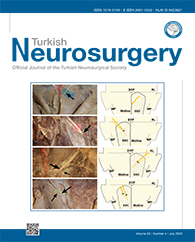2Gazi University, School of Medicine, Department of Neurosurgery, Ankara, Turkey
3Acibadem Mehmet Ali Aydinlar University, School of Medicine, Istanbul, Turkey
4Kafkas University, Health Research and Application Center, Department of Neurosurgery, Kars, Turkey DOI : 10.5137/1019-5149.JTN.40190-22.3 AIM: To report our experience with flow diverter devices in the treatment of intracranial aneurysms, and to share the efficacy and clinical results of the Derivo® flow diverter device in the endovascular treatment of cerebrovascular aneurysms.
MATERIAL and METHODS: This retrospective study was conducted at a regional training and research hospital between October 2015 and March 2020 after approval by the Clinical Research Ethics Committee. The radiology and file records of 21 patients with cerebrovascular aneurysms treated endovascularly using a Derivo® flow diverter device were examined.
RESULTS: As per our findings, flow diverter devices were used to treat 27 aneurysms from 21 cases. Among the treated aneurysms, 3, 2, and 22 were in the middle cerebral artery, anterior communicating artery, and internal cerebral artery, respectively. Eight of the patients with a mean age of 56.9 years presented with subarachnoid hemorrhage. Derivo® flow diverters were used alone in 19 cases, whereas concurrent diverter device and coiling were used in only 3 patients. Complete closure of the aneurysms was observed in 3 (14.2%) cases; meanwhile, a 50% reduction in aneurysm size was observed in 2 (9.5%) cases. Complete aneurysm closure occurred in 20 cases (95%) at the 6-month follow-up. Mortality and morbidity each occurred in 1 (4.7%) case.
CONCLUSION: Flow diverter devices provide an efficient and safe method of treatment, especially for fusiform, large, giant, widenecked intracranial aneurysms. Endovascular coil embolization treatment is deemed inappropriate for small aneurysms.
Keywords : Aneurysm, Cerebrovascular, Derivo® flow diverter, Endovascular




